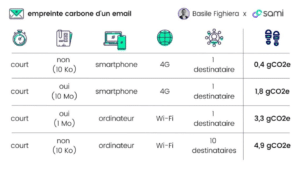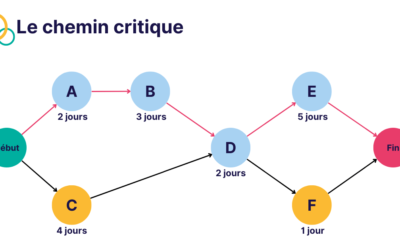In 2021, e-mail turns 50 years old. Every day, more than 330 billion e-mails are sent worldwide. This means of communication is still widely used despite the many new tools that have been developed in recent years (instant messaging, video conferencing, corporate social networks, etc.).
However, today, e-mail is increasingly suffering from a bad reputation. This is due to the digital pollution it helps generate, but also to its impact on employee productivity.
Here is a brief overview of the impact of e-mail on the environment and on the productivity of your employees, and the solutions to help you reduce the use of e-mail in your company.
The environmental impact of e-mail
How many e-mails have you already received today? And yesterday? And how many have you sent? In France, nearly 1.4 billion e-mails are sent every day. Although e-mail undoubtedly has an impact on the environment, this varies according to many parameters.
Until 2022, it was estimated that a single e-mail emitted 4 gCO2e (CO2 equivalent) and that an e-mail with an attachment could emit up to 50 gCO2e.
Today, new calculations have been made because the carbon impact of an e-mail is very variable and depends on its use and configuration. Thus, to estimate the carbon impact of an e-mail, one must consider.
– the length of the content of the e-mail.
– whether or not it has an attachment.
– the weight of the attachment.
– from which device it is sent.
– which network it is sent over (Wi-Fi or 4G).
– how many recipients it is addressed to.
According to Sami, a platform that allows companies to measure their impact and reduce their emissions, here are some estimates of the carbon footprint of an email:

A short e-mail without an attachment (10 Kb) written and read on a smartphone with a 4G connection, to 1 recipient: 0.4 gCO2e.
A short e-mail with a large attachment (10 MB) written and read on a smartphone with a 4G connection to 1 recipient: 1.8 gCO2e.
An e-mail with an attachment (1 MB) written on a computer with a Wi-Fi connection to 1 recipient: 3.3 gCO2e.
A short e-mail without attachment (10 Kb) written on a computer with a Wi-Fi connection to 10 recipients: 4.9 gCO2e.
To help reduce your environmental impact, give preference to short e-mails, without attachments, sent to a single recipient from your business smartphone via the 4G network.
The impact of e-mail on productivity
In addition to the pollution it generates, an e-mail also tends to harm the productivity of your employees. It is not suitable for collaboration, nor for initiating discussions with your team. For that, there are much better tools such as instant messaging.
Chat vs email: find out when to use one rather than the other.
In addition, an e-mail can easily go unnoticed in an overloaded mailbox, or it can be deleted by mistake. Many emails go unanswered. It is also difficult to find information in an e-mail, or an attachment in your inbox. Time is wasted and we often have to ask the sender to resend the information. Not to mention the “copy everyone” crowd that saturates their colleagues’ mailboxes and needlessly diverts their attention from their tasks.
Tips for reducing e-mail use.
You want to reduce the use of e-mail in your organization not only to reduce digital pollution, but also to increase employee productivity. Here’s how to go about it.
1. Move or use the phone
If you work in your company’s offices, next to your colleagues, don’t hesitate to walk over and ask them directly for information. As well as getting some exercise, you will socialise and improve your relationship with your colleagues. You can put a face to Carine in accounting and get to know Thomas in marketing better.
If you are teleworking, use the telephone instead of e-mail. Having a face-to-face discussion is a good way to break the isolation that can sometimes be felt when working remotely. It also strengthens the sense of belonging and team cohesion.
2. Use appropriate tools
As we have seen, e-mail is not suitable for fostering collaboration, creating a group discussion, or exchanging views directly with your team or a colleague. For this purpose, use instant messaging instead. You can easily chat with your team members, share a document, or create discussion groups on a specific project or topic.
To share information on company news, opt for the corporate social network. It is an ideal tool to unite employees, develop team cohesion and strengthen the sense of belonging, especially if your employees work remotely.
Often, a physical or virtual meeting lasting a few minutes is much more effective than an e-mail for addressing a difficult situation, finding a solution to a problem, congratulating an employee, or motivating a team.
Finally, opt for collaborative platforms such as Wimi, which bring together all the essential tools to facilitate collaboration and communication. With Wimi, you have a chat, a video conferencing system, a document storage space, and many other features that allow you to manage your projects efficiently without having to send e-mails (or almost).
3. Sort, store and delete your e-mails
To use e-mail efficiently, it is essential to organise your mailbox, sort incoming e-mails and delete those you no longer need. Also consider clearing out spam.
There are many ways to improve your daily e-mail management. For example, the Inbox Zero method, which consists of having an almost empty inbox so that you no longer stress about your (too many) e-mails and reduce your digital pollution. You can also set up one e-mail-free day per week.
With these tips, you can limit the use of e-mail in your organisation and reduce your environmental impact. It’s up to you!








